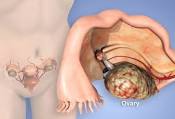- You are here:
- Home »
- Blog »
- Uncategorized »
- Ovarian Cysts-Watchful Waiting vs. Surgical Complications…
Ovarian Cysts-Watchful Waiting vs. Surgical Complications…

the risks of watchful waiting (of ovarian cysts) have to be balanced against the risks of surgical complications, the study authors concluded…
A diagnosis of ovarian cysts is difficult. Deciding to do nothing but watch and wait is even more difficult. Why? Because surgeons what to cut and medical doctors usually want to treat. That’s not a criticism, it is a statement of fact. Treating diagnoses are what doctors are trained and paid to do.
Which is why watchful waiting can be difficult. And I’m not writing this blog post to encourage you to do anything other than learn the facts. According to the article below, a diagnosis of ovarian cysts should lead to learning the pros and cons of treating vs. not treating.
According to the information below .4 percent of ovarian cyst were later diagnosed with ovarian cancer, “ovarian twisting” or cyst rupture occured .4 percent and .2 percent respectively. More than 80% of the time, the ovarian cyst disappeared or did not require surgery. The risks of surgery are listed below.
My point is that you should learn all of your options if you are diagnosed with ovarian cysts.
Scroll down the page to post a question or a comment.
Thank you,
David Emerson
- Cancer Survivor
- Cancer Coach
- Director PeopleBeatingCancer
Recommended Reading:
- Why Ovarian Cancer Is Often Misdiagnosed
- New Guideline for Surveillance of Gynecologic Cancers
- Proof that Cancer Second Opinion is Critical
Benign Ovarian Cysts Should Be Left in Place, Study Suggests
“It’s a common gynecological finding: A growth on an ovary, which turns out to be a benign cyst. Is surgical removal necessary?
Not always, according to data from a new study of more than 1,900 such cases in which outcomes were tracked for two years post-diagnosis.
The team behind the research now believes that most women with non-cancerous ovarian cysts can simply be monitored over time, instead of having invasive surgery to remove the growths….
As described by the researchers, ovarian cysts are fluid-filled sacs that develop on ovaries and are identified through ultrasound scans. They’re common and usually don’t cause any symptoms, but in some cases do result in pelvic pain and bloating…
Cysts can be non-cancerous (benign) or cancerous, and should always be removed if suspected to be cancerous. However, even when a cyst is benign, doctors often recommend removal due to concerns about serious complications, such as the cyst bursting or causing the ovaries to twist. There’s also the possibility that a benign cyst might turn cancerous, or that it was initially misidentified as benign.
But surgery comes with risks and complications of its own. And so with benign cysts, doctors sometimes instead turn to “watchful waiting” — conducting scheduled ultrasound scans to monitor cyst size and appearance. Many ovarian cysts will go away over time or do not change…
In an attempt to decide the issue, Bourne and his colleagues tracked two-year outcomes for 1,919 women, average age 48, in 10 countries. All of the women underwent monitoring scans for two years after being diagnosed with benign cysts. The average cyst size was 4 centimeters (1.6 inches).
- In one in five cases or 20%, the cysts simply disappeared on their own-
- In another 16 percent of cases, women eventually went on to have cyst-removing surgery.
- But, overall, in 80 percent of the cases, either the cyst disappeared or did not require surgery, the investigators found.
Only a very small number — 12 women, or just 0.4 percent — were later diagnosed with ovarian cancer.
The rate of ovarian twisting or cyst rupture was also very small — 0.4 percent and 0.2 percent, respectively.
Based on these findings, the risks of watchful waiting have to be balanced against the risks of surgical complications, the study authors concluded. The risk of surgical complications — such as bowel perforation — among women aged 50 to 74 is between 3 percent and 15 percent, they noted.
“Despite these surgical risks being small, if the women in this age group underwent surgery in our study, then we could speculate that 29 to 123 of them could have suffered severe surgical complications.”
“Instead, only 96 of them underwent surgery, which means severe complications may have been avoided in between 29 to 123 women,”
One U.S. expert agreed that the issue of how to deal with benign cysts has been a difficult one, with most doctors erring on the side of caution.
“Though opinion is divided, the majority of surgeons around the world believe benign ovarian cysts should be surgically removed…”
However, the new data “suggest the benefit of watchful waiting without surgery…“


